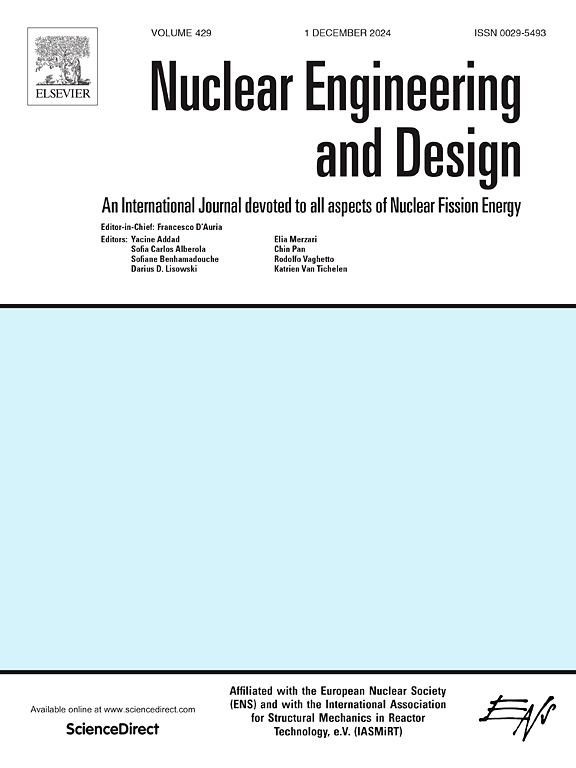A comparative analysis of the flow in a rod bundle with two guide-tubes and mixing grids, URANS simulation and Wall-Modeled LES of the ALAIN experiment
IF 1.9
3区 工程技术
Q1 NUCLEAR SCIENCE & TECHNOLOGY
引用次数: 0
Abstract
The flow characteristics in a 5 × 5 rod bundle representative of ALAIN experiment is investigated using Unsteady Reynolds-Averaged Navier–Stokes and Wall-Modeled Large Eddy Simulation methodologies. A review of the numerical methodology is first presented to highlight the impact of mesh resolution and computational domain size on simulation outcomes. Experimental measurements of the velocity along two traverses of the rod-bundle lattice are then employed as reference data to evaluate the accuracy of computational fluid dynamics simulations. The average error on the velocity statistics reveals substantial discrepancies between the numerical results and experimental measurements. The disturbance induced by the mixing grids and the presence of guide-tubes represent a challenging feature to reproduce numerically, both at close and long distance from the grids. Computation on the error made on the velocity statistics reveals that Wall-Modeled Large Eddy Simulation perform better than the URANS model to predict the axial velocity at close distance from the grid and the transverse flow at large distance from the grid, but comes at a much higher computational cost. The present analysis enhances the understanding of flow dynamics in rod bundles and informs the selection of appropriate turbulence models for future simulations.

两导管混合网格杆束流动、URANS模拟与ALAIN实验壁面模拟的对比分析
采用非定常reynolds - average Navier-Stokes和壁面大涡模拟方法研究了ALAIN实验中具有代表性的5 × 5杆束的流动特性。首先介绍了数值方法的回顾,以突出网格分辨率和计算域大小对模拟结果的影响。然后采用沿杆束晶格两遍历的速度实验测量值作为参考数据来评估计算流体动力学模拟的准确性。速度统计的平均误差揭示了数值结果与实验测量之间的巨大差异。混合网格和导管的存在所引起的扰动是一个具有挑战性的特征,无论是在离网格近的地方还是在离网格远的地方。对速度统计误差的计算表明,壁式大涡模拟在预测离网格近的轴向速度和离网格远的横向流动方面比k−λ URANS模型表现得更好,但计算成本要高得多。本文的分析提高了对抽油杆束流动动力学的理解,并为今后的模拟选择合适的湍流模型提供了指导。
本文章由计算机程序翻译,如有差异,请以英文原文为准。
求助全文
约1分钟内获得全文
求助全文
来源期刊

Nuclear Engineering and Design
工程技术-核科学技术
CiteScore
3.40
自引率
11.80%
发文量
377
审稿时长
5 months
期刊介绍:
Nuclear Engineering and Design covers the wide range of disciplines involved in the engineering, design, safety and construction of nuclear fission reactors. The Editors welcome papers both on applied and innovative aspects and developments in nuclear science and technology.
Fundamentals of Reactor Design include:
• Thermal-Hydraulics and Core Physics
• Safety Analysis, Risk Assessment (PSA)
• Structural and Mechanical Engineering
• Materials Science
• Fuel Behavior and Design
• Structural Plant Design
• Engineering of Reactor Components
• Experiments
Aspects beyond fundamentals of Reactor Design covered:
• Accident Mitigation Measures
• Reactor Control Systems
• Licensing Issues
• Safeguard Engineering
• Economy of Plants
• Reprocessing / Waste Disposal
• Applications of Nuclear Energy
• Maintenance
• Decommissioning
Papers on new reactor ideas and developments (Generation IV reactors) such as inherently safe modular HTRs, High Performance LWRs/HWRs and LMFBs/GFR will be considered; Actinide Burners, Accelerator Driven Systems, Energy Amplifiers and other special designs of power and research reactors and their applications are also encouraged.
 求助内容:
求助内容: 应助结果提醒方式:
应助结果提醒方式:


